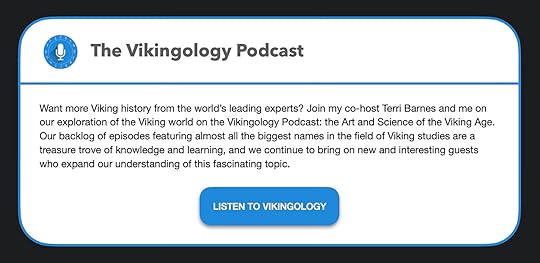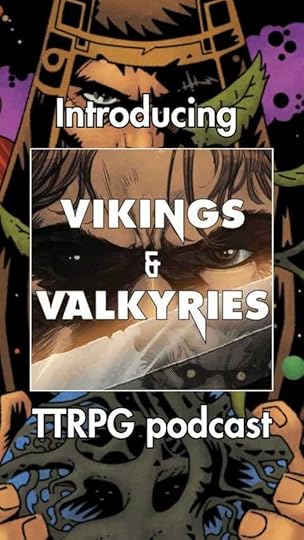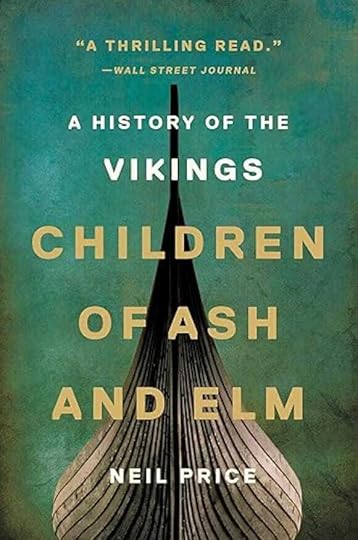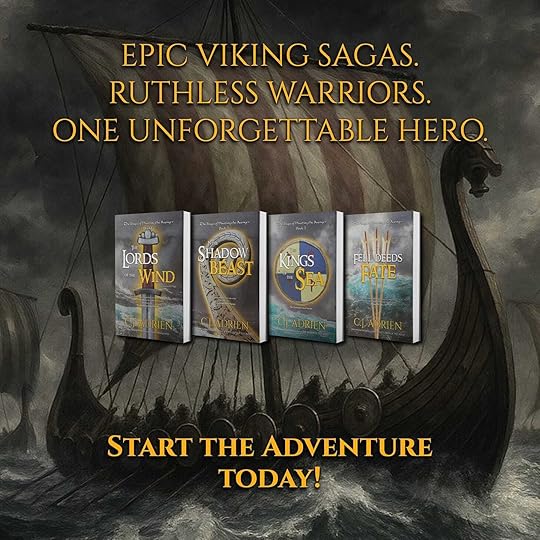How Did the Vikings View and Treat Homosexuality?
Welcome to the newsletter, where history, storytelling, and inspiration meet. Every week, I share some of the fun historical research I’ve done while writing my novels, writing reflections (and sometimes tips), and sharing updates on my work and journey. If you were forwarded this message, you can join the weekly newsletter here.
Today’s DispatchNíð, Ergi, and Viking Attitudes Toward Homosexuality.
The Algorithm That Got Away.
Vikings and Valkyries on Valhalla Conversations.
This week’s book recommendation.
 Viking HistoryNíð, Ergi, and Viking Attitudes Toward Homosexuality
Viking HistoryNíð, Ergi, and Viking Attitudes Toward HomosexualityOne of the concepts I’ve played with in my novels is homosexuality. We know that in other areas of history, societies grappled with same-sex attraction in various ways, and it makes sense that the Vikings would have had to grapple with it as well. In my research, I’ve found that what we think we know about Viking attitudes toward homosexuality starts with two words: nið and ergi. In the Viking Age, insults carried tremendous weight. Words like níð and ergi were serious accusations tied to ideas of honor, masculinity, and social order. To understand how Viking Age Norse society viewed same-sex behavior, we must begin with these terms.
 A Niðstöng, photo credit ØYVIND NONDAL/FLICKRWhat Was Níð?
A Niðstöng, photo credit ØYVIND NONDAL/FLICKRWhat Was Níð?Níð was a powerful insult. It could mean cowardice, dishonor, or lawlessness, but it also had strong sexual connotations, including accusing a man of being a passive participant (i.e., a ‘bottom’) in a homosexual relationship. From níð came words like níðingr (a coward or outcast), níðvisur (insulting verse), and níðstöng (a scorn-pole used in rituals to publicly shame someone). A man could be accused of being sannsorðinn, or “homosexually used by another man,” which was considered one of the most offensive things you could say about someone. So far as we know, there were few negative consequences for taking an active role (i.e., a ‘top’) in such affairs. Therefore, we are not looking at a society that outright rejected homosexuality, but rather incorporated it into dominance and power structures within their social constructs.
What Was Ergi?Closely tied to níð was the concept of ergi. The associated adjective argr meant effeminate, unmanly, or inclined to play the female role in sex. In Viking thought, this was deeply shameful because the passive role was viewed as a sign of weakness. Viking masculinity centered on independence, courage, and dominance. A man who submitted sexually to another man was believed to also submit in other areas and couldn’t be trusted to lead, fight, or act honorably.
This is reflected in specific law codes. In both Grágás (Icelandic) and Gulaþing (Norwegian), calling a man argr, stroðinn, or sannsorðinn was grounds for outlawry and justified violence. These insults were considered “killing words,” as uttering them had deadly consequences, and there were rules for when and how to use them.
Christian InfluenceBefore Christianity, same-sex behavior may have been tolerated in specific contexts, especially when it didn’t disrupt social expectations like marriage and reproduction. Men were expected to marry and have children to maintain the household and support family lines. So long as that happened, affectional preferences may have been overlooked.
With the Christianization of Scandinavia came new moral frameworks. Christian texts from the 12th and 13th centuries condemned homosexuality in the active and passive roles. Men and women who avoided marriage due to same-sex preference were labeled and shamed. For example, fuðflogi meant “he who flees the female sex organ,” and flannfluga meant “she who flees the male sex organ.”
Lesbianism is almost entirely absent from pre-Christian Norse texts. When mentioned, it is framed through Christian moralizing. Old Norse language didn’t even have a clear vocabulary to describe same-sex relationships between women. The focus was always on whether individuals performed their expected roles in society.
Gods, Heroes, and ContradictionsNorse mythology complicates the picture. Odin, the Allfather, was mocked for practicing seiðr, a magical art associated with women and the concept of ergi. Loki famously took the form of a mare and gave birth to a foal. Neither god loses their status as a result of these behaviors. There are hints in myth and ritual that certain priesthoods, especially those devoted to fertility gods like Freyr, may have included men who engaged in behaviors seen as argr by later Christian standards.
In some heroic literature, the boundaries between fiction and reality become even more blurred. The Icelandic poem Grettisfærsla claims that the protagonist Grettir had sex with "maidens and widows, everyone's wives, farmers' sons, deans and courtiers, abbots and abbesses, cows and calves, indeed with near all living creatures," yet he remains a hero. The contradiction points to a more flexible pre-Christian morality, one reshaped by Christian authors who wrote down these stories centuries after the Viking Age had ended.
Final ThoughtsThe Icelandic poem Grettisfærsla claims that the protagonist Grettir had sex with "maidens and widows, everyone's wives, farmers' sons, deans and courtiers, abbots and abbesses, cows and calves, indeed with near all living creatures," yet he remains a hero.
I explored this complexity in my novel, The Lords of the Wind, through the character Egill, who, like Odin, practices the magical art of seiðr and is accused by Jarl Magnus of Ribe of seducing his brother. The accusation is meant to destroy his reputation, not because it’s necessarily true, but because it frames him as unmanly. Jarl Magnus is enraged; King Horic is unbothered. Their reactions are intended to reflect the spectrum of historical attitudes toward ergi—some rooted in power and shame, while others are more pragmatic. I further explore this concept in later novels with other characters who escape scorn for their behavior, provided they fulfill their social obligations within the warband. When they fail, disaster awaits them as they become the scapegoats for the failure. In this way, fiction can give voice to the subtleties that the historical record only hints at.
Further reading:
On homosexuality in the Viking Age: https://origin.web.fordham.edu/halsal....
On Nið and Ergi: http://vsnrweb-publications.org.uk/Ni...
Writing and PublishingChasing #1, and the Algorithm That Got AwayLast month, I landed something every indie author dreams about: a BookBub Featured Deal. These are notoriously hard to get, and when you do, they can send your book shooting to the top of the charts. That’s precisely what happened—The Fell Deeds of Fate hit #1 in Historical Norse & Icelandic Fiction in the UK.
But here’s the part that surprised me: it didn’t stay there.
In the past, a BookBub push would have driven sales for more than a couple of days. With the Lords of the Wind, it triggered Amazon’s recommendation algorithm, which picked up the momentum and kept the book visible for weeks. But this time, despite strong ongoing sales, my rank dropped back down within 48 hours. I went from #1 to #37 overnight, despite still selling copies.
After digging into it and speaking with other authors, it looks like Amazon has quietly adjusted how the algorithm works. Sudden spikes in sales (like those caused by ads or feature deals) no longer carry as much weight. Instead, Amazon now appears to favor steady, long-term sales and external traffic, particularly clicks originating from trusted referrers such as email newsletters, websites, and organic search.
It’s a tough shift. It means the days of riding the wave of a single big promo might be behind us. Now, consistent effort and diverse traffic sources seem to matter more than ever. As always, I suspect this change occurred as a deal between Amazon and the big six publishing ‘cartel’, as I call them, giving priority and preference to traditionally published books over indie ones.
That said, I’m still proud of the Featured Deal. It attracted a significant number of new readers, provided the series with increased visibility, and contributed to building momentum for the rest of my catalog. But it’s a good reminder: we’re not playing the same game we were five years ago.
The landscape is shifting. The question now is: how do we, as authors, change with it so we don’t get relegated to the dustbin?
Author UpdateVikings and Valkyries on Valhalla Conversationssoulchaserbecky A post shared by @soulchaserbecky
A post shared by @soulchaserbeckyThe cast of the live-play podcast Vikings and Valkyries—yes, including me!—recently appeared on an episode of the Valhalla Conversations podcast to lift the lid on what really happened behind the scenes. We shared how the show came together, our favorite unscripted moments, what it was like to roleplay Viking-related characters, and the unpredictable dynamics that unfolded when a group of creatives, academics, and chaos gremlins collided in a shared Norse mythos.
If you’ve ever wondered how much of the show was improvised, how we developed our characters, or what we actually thought of each other (spoiler, Bill and Steve are old friends!)—this one’s worth a listen.
Keep an eye out—the episode drops June 6th at the link below:
Book RecommendationsChildren of Ash and Elm, by Neil Price
Blurb:
The Viking Age -- from 750 to 1050 -- saw an unprecedented expansion of the Scandinavian peoples into the wider world. As traders and raiders, explorers and colonists, they ranged from eastern North America to the Asian steppe. But for centuries, the Vikings have been seen through the eyes of others, distorted to suit the tastes of medieval clerics and Elizabethan playwrights, Victorian imperialists, Nazis, and more. None of these appropriations capture the real Vikings, or the richness and sophistication of their culture.
Based on the latest archaeological and textual evidence, Children of Ash and Elm tells the story of the Vikings on their own terms: their politics, their cosmology and religion, their material world. Known today for a stereotype of maritime violence, the Vikings exported new ideas, technologies, beliefs, and practices to the lands they discovered and the peoples they encountered, and in the process were themselves changed. From Eirík Bloodaxe, who fought his way to a kingdom, to Gudrid Thorbjarnardóttir, the most traveled woman in the world, Children of Ash and Elm is the definitive history of the Vikings and their time.
Why I recommend it:
It’s one of the most comprehensive and up-to-date histories of the Viking Age available. Price draws from the latest research and manages to challenge old tropes without falling into the trap of overcorrecting. Best of all, he avoids the repetitiveness that plagues many general Viking histories—every chapter brings something fresh.
And, as always…Buy my novels!



